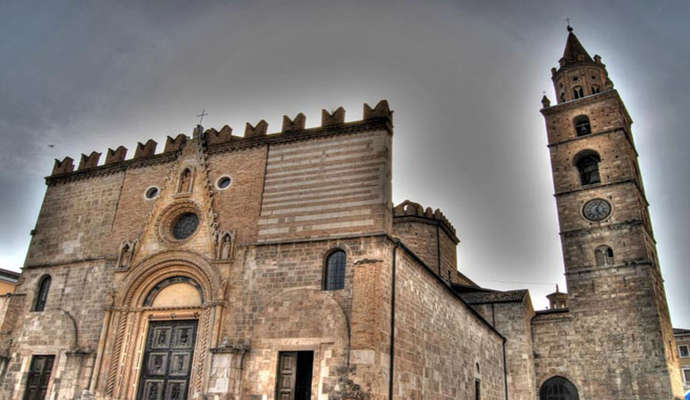|
:: ::
| I Viaggi Del Gusto UNDER THE TUSCAN SUN |
|
 ABRUZZO HIGHLIGHTS ABRUZZO HIGHLIGHTS
- THE BEST PARKS GRAN SASSO AND MAJELLA
- CRAFT AND SMALL VILLAGES ALONG THE D'ANNUNZIO POET FOOTSTEPS
- THE COAST OF TRABOCCHI
- THE TRADITION OF TRANSHUMANCE ALONG THE WINE AND FOOD ROAD
|
LIST PRIVATE GUIDED TOURS : ABRUZZO AS YOU WANT
|
|
|
ABRUZZO AUTHENTIC LANDS for Detox: ANCIENT TRADITIONS AND DEEP LANDSCAPES BETWEEN THE MOUNTAIN AND THE SEA
Do you like traveling because discovering the past, origins and ancient traditions explains the present?
You love to have authentic experiences to detoxify from the stressful everyday life without traveling with the eyes of tourists
... so you are looking for a slow time off the tourist routes ... what you can't find by yourself ...
.. FOLLOW YOUR DREAM and WE GUIDE YOU IN THE EXPERIENCE, THAT WE ONLY DO ONLY FOR YOU !!!
|
CONTACT OUR
EMOTIONS' SAILOR 
|
DISCOVER ABRUZZO
|
|
_________________
VISIT ABRUZZO
_________________
ABRUZZO
EXPERIENCES
ABRUZZO POETRY LAND OF SILENCE AND VILLAGES [......]
_________________
|
|
MAIN CITIES
AQUILA DESTROYED BY THE EARTHQUAKE

The city of L'Aquila, also known as the Florence of Abruzzi or the Salzburg of Italy, is determined to quickly recover from the 2009 earthquake: securing and restoration of buildings and monuments started immediately after the tragedy. Sulmona, hometown of the Latin poet Ovidio, is very rich in monuments and works of art. It has also a thriving handicrafts industry and it is well-known for its typical confetti (sugared almond confections). Castel di Sangro, on the southern border of the province, is dominated by the Collegiata dell'Assunta, a little 13th century architectonic jewel with two portals, a Renaissance one and Romanesque one. Tagliacotto, on the slopes of Mount Bove, is well-known for its ancient noble residences. The territory of L'Aquila presents ruins of ancient pagan temples together with Roman settlements reflecting the religious traditions of the land, such as the many Benedictine monumental complexes of the Romanesque age: the S.Pietro Church in Alba Fucense, built on the ruins of a pagan temple and with its characteristic 13th century mosaics; the S. Maria in valle Porclaneta Church in Rosciolo, at the foot of Mount Velino; the S.Maria and S. Pellegrino monumental complex in Bominaco, on the tableland of Navelli. The Cathedral of S. Pelino in Corfino is also sightworthy. Finally, the town of Scanno is really sightworthy, with its lake and the famous Sagittario and Aterno gorges..
PESCARA

province of Pescara was created with the foundation of its namesake city in 1927, after the union of two historic rivals: the villages separated one from the other by the Atero River, Pescara and Castellamare Adriatico. The territory extends from the Adriatic coastline as far as the heights of the Central Apennine massifs. It borders on the Province of Teramo (north), the Adriatic Sea (northeast), Chieti (east) and L'Aquila (south and west). The Provincial Government Building and the City Hall are in piazza Italia. Corso Monthonè, the main street of the old city, is the centre of nightlife. The Vittoria Colonna Museum of Modern Art, in the heart of the city, opened a few years ago. Furthermore, one of the most visited places is the birthplace of Gabriele D'Annunzio.
The province presents other sightworthy museums, such as the Paolo Barrasso Naturalistic and Archaeological Museum of Caramaico Terme, and the Museum and Archives of Contemporary Artists of Abruzzi hosted in the Nocciano Castle. Then there are the San Clemente Abbey of Casauria (Castiglione a Casauria), the Museum of Traditions and Folk Arts (Picciano), the Museum of the Salle Castle, the Ducal Tavern (Popoli) and the Oil Museum (Loreto Aprutino).
The territory of Pescara, like the other four provinces of Abruzzi, preserves an important natural patrimony: worth mentioning are the National park of Gran Sasso and Monti della Laga, the Majella National Park, but also the natural reserves of Pineta di Santa FIlomena, Valle dell'Orfento, Lama Bianca di Sant'Eufemia a Maiella and Piana Grande della Majelletta. And then there are the provincial reserves of Lago di Penne, la Pineta Dannunziana (D’Annunzio’s pine grove) and the natural guided reserve Sorgenti del Fiume Pescara
CHIETI

Chieti is the fourth municipality in Abruzzi for number of inhabitants and over time it has been dominated by the Angioini family, the Aragonesi family and the French, in the 19th century . It stands on a hill which separates the Aterno-Pescara waters from the Alento ones. The city comprises of two parts: Chieti Alta (the higher part) including the old city centre, and Chieti Scalo, (the newest part) including the university campus.
The Cathedral of S. Giustino is the biggest and most important church in town. The municipal villa, a neoclassic residence, hosts the National Archaeological Museum of Abruzzi. The exhibition of frescos, paintings and ceramics of the Museum of Art "Costantino Barbella", hosted in the Martinelli-Bianchi palace, and the Museum of sacred art of Ortona are also impressive.
Vasto is the second largest town of the province for number of inhabitants and, like Chieti, has pre-Roman origins. Vasto coastline is one of the favourite seaside destinations of the region. The province also offers the Roman thermae, the Municipal Archaeological Museum and the Diocesan Museum of Lanciano. In 2002 the Museum of the Battle Ortona-MUBA '43 opened its doors: it presents a thematic path recreating the battle of Ortona, to commemorate the 1314 civilian victims and the Canadian and German soldiers who died in December 1943. The il Museum of sacred art in Ortona and the Art Museum Costantino Barbella situated in the Martinelli-Bianchi palace are also impressive the latter houses the exhibition of frescoes, canvases and ceramics
TERAMO

In Roman times, Teramo was called Interammnia (city between two rivers), as it's crossed by the Tordino and the Vezzola rivers. It is 20 km far from the adriatic coastline and 40 km far from the Gran Sasso.
It's a historical and very charming city: its foundation dates back to Phoenician times and it is still full of archaeological finds proving the passage of different peoples, such as funerary treasures similar to the Picene tombs ones. Today its monuments testify its different dominations, from Francesco Sforza to Alfonso d'Aragona, from the Spanish and the French to the Realm of Naples in the XIX century. The major museum is the F. Savini Archaeological Museum. Among the major artistic monuments of the city there is the Romanesque Cathedral of Santa Maria Assunta and San Bernardo. The Church of the Madonna delle Grazie, raising on a Benedectine convent, is also sightworthy. Among its historical buildings there is the Melatino house (Largo Melatini), a 12th century medieval building.
Roseto degli Abruzzi, best known as Lido delle Rose, is one of the major tourist resorts of the coast: its wide sandy beaches and shallow waters are among the most beautiful and clean of the Adriatic sea. The hilly part of the city is very nice to visit, too: the Sant'Antimo church, probably built by Pope Sisto V, and the SS. Annunziata church, dating back to the end of the 16th century, are sightworthy. In summer, the Roseto Opera Prima film festival brightens up the coastline gathering many Italian movie makers and film stars.
Giulianova was built on an ancient Roman settlement, Castrum Novum. Today it's an important industrial centre and tourist resort of the region. It consists of the coastal area and the old city centre, built in the 16th century on the top of the hill. Here there are the Duomo of San Flaviano, the seaside Belvedere at Piazza Vittorio Emanuele and the charming Shrine of the Madonna dello Splendore, celebrating the apparition of the Madonna to a peasant in 1557. The Museum of Art dello Splendore, the Torrione "Il Bianco" Archaeological Museum, the Hall of the Sculptor Raffaello Pagliaccetti, the de' Bartolomei Chapel and the Gaetano Braga House-Museum are also sightworthy.
The necropolis of Campovalano includes about ten thousand tombs, presumably related to the presence of Piceni.
|